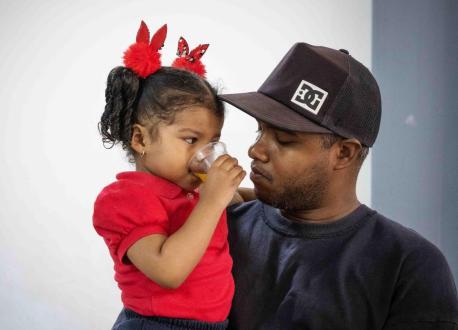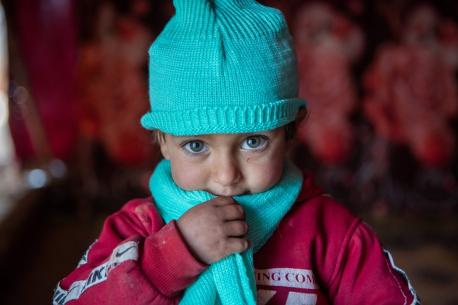Stopping a killer disease with boats, bicycles and bednets
Malaria is the single most important cause of illness in the Democratic Republic of Congo (DRC). Out of the country’s population of 72 million - nearly all are at risk of contracting the disease. Malaria here is responsible for nearly 200,000 deaths every year - the equivalent of 366 plane (747) crashes. You would think that providing this simple, cost-effective and lifesaving solution over the beds of those who need it most would be pretty straightforward. Yet, given the complex terrain of areas where the transmission of malaria is highest, the distribution of millions of needed bednets is one of the most challenging tasks faced by UNICEF as well as other humanitarian organizations working on the ground to stop this deadly disease. Back in 2009, UNICEF helped organize a historic campaign where 5.5 million nets were distributed at a cost of about US $32 million to protect at least 11 million people living in DRC’s provinces of Orientale and Maniema. These nets were transported by barge, bicycle, canoe, trucks and sheer human effort. This year, we’re at it again with another extraordinary series of campaigns! Our goal for 2012 is to distribute 13.7 million mosquito nets in four provinces across the country.
Alphonse Toko is Head of UNICEF's Democratic Republic of Congo Malaria Program.
Malaria is the single most important cause of illness in the Democratic Republic of Congo (DRC). Out of the country’s population of 72 million - nearly all are at risk of contracting the disease. Malaria here is responsible for nearly 200,000 deaths every year - the equivalent of 366 plane (747) crashes.
Insecticide treated bed nets – especially those treated to retain their effectiveness for three years or more, are one of the most effective ways of protecting people from malaria.
You would think that providing this simple, cost-effective and lifesaving solution over the beds of those who need it most would be pretty straightforward. Yet, given the complex terrain of areas where the transmission of malaria is highest, the distribution of millions of needed bednets is one of the most challenging tasks faced by UNICEF as well as other humanitarian organizations working on the ground to stop this deadly disease.
In order to cover all of DRC’s 72 million inhabitants, approximately 40 million long lasting insecticide treated bednets are needed. UNICEF has been at the forefront of moving these nets into the homes where they are needed most, by handing out mosquito nets during routine immunizations.
Back in 2009, UNICEF helped organize a historic campaign where 5.5 million nets were distributed at a cost of about US $32 million to protect at least 11 million people living in DRC’s provinces of Orientale and Maniema. These nets were transported by barge, bicycle, canoe, trucks and sheer human effort. Men, women and children all came, transporting the nets on their heads, in their arms, slung over their shoulders---every which way to ensure that the nets reached affected far-flung rural communities.
This year, we’re at it again with another extraordinary series of campaigns! Our goal for 2012 is to distribute 13.7 million mosquito nets in four provinces across the country. Of these, 5.3 million will be in Katanga province alone.
 Road conditions in Katanga are such that it is impossible to use long-haul vehicles. In order to distribute the 5.3 million mosquito nets throughout the province, the vast majority of nets will be delivered by 20-ton trucks with a capacity of up to 40 cubic meters. Katanga is immense - in order to reach all of its 68 health zones, more than 125, 517 miles will need to be traveled by trucks, boats, bicycles, trains and aircraft. To add more perspective: if only one truck was used to cover this distance it would circumnavigate the globe 5 times.
In 2008, the UN Secretary General called for universal coverage with anti-malarial interventions. To reach this goal, there has been renewed commitment and focus on DRC which bears the second highest brunt of malaria morbidity and mortality after Nigeria.
We’re determined to combat malaria because too many children under five and pregnant women die of the disease. Studies show that malaria represents 42% of clinical consultations and 39% of fatalities in hospitals for children under five years old. It is estimated that for every 1,000 children born in the DRC, 158 will not see their fifth birthday - that’s more than 400,000 children dying every year. Many of them die of malaria.
But malaria is preventable and treatable and your support makes all the difference in making lifesaving endeavors such as this one a reality.
Help stop a killer disease. Give a lifesaving mosquito net through UNICEF Inspired Gifts.
Road conditions in Katanga are such that it is impossible to use long-haul vehicles. In order to distribute the 5.3 million mosquito nets throughout the province, the vast majority of nets will be delivered by 20-ton trucks with a capacity of up to 40 cubic meters. Katanga is immense - in order to reach all of its 68 health zones, more than 125, 517 miles will need to be traveled by trucks, boats, bicycles, trains and aircraft. To add more perspective: if only one truck was used to cover this distance it would circumnavigate the globe 5 times.
In 2008, the UN Secretary General called for universal coverage with anti-malarial interventions. To reach this goal, there has been renewed commitment and focus on DRC which bears the second highest brunt of malaria morbidity and mortality after Nigeria.
We’re determined to combat malaria because too many children under five and pregnant women die of the disease. Studies show that malaria represents 42% of clinical consultations and 39% of fatalities in hospitals for children under five years old. It is estimated that for every 1,000 children born in the DRC, 158 will not see their fifth birthday - that’s more than 400,000 children dying every year. Many of them die of malaria.
But malaria is preventable and treatable and your support makes all the difference in making lifesaving endeavors such as this one a reality.
Help stop a killer disease. Give a lifesaving mosquito net through UNICEF Inspired Gifts.

A pirogue with mosquito nets bound for villages not accessible to motor vehicles around Kindu,in Eastern DR Congo. | © UNICEF



